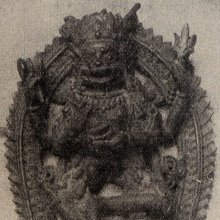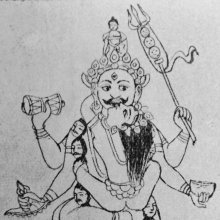Mahayashas, Mahāyasa, Mahāyaśa, Mahayasha, Mahāyaśas, Mahayasa, Maha-yashas, Mahāyaśā: 21 definitions
Introduction:
Mahayashas means something in Buddhism, Pali, Hinduism, Sanskrit, Jainism, Prakrit. If you want to know the exact meaning, history, etymology or English translation of this term then check out the descriptions on this page. Add your comment or reference to a book if you want to contribute to this summary article.
The Sanskrit terms Mahāyaśa and Mahāyaśas and Mahāyaśā can be transliterated into English as Mahayasa or Mahayasha or Mahayasas or Mahayashas, using the IAST transliteration scheme (?).
Images (photo gallery)
In Hinduism
Purana and Itihasa (epic history)
Source: archive.org: Puranic EncyclopediaMahāyaśas (महायशस्).—A woman follower of Subrahmaṇya. (Mahābhārata Śalya Parva, Chapter 46, Verse 28).
Source: archive.org: Shiva Purana - English TranslationMahāyaśas (महायशस्) refers to “one of great glory” and is used to describe Brahmā, according to the Śivapurāṇa 2.5.1 (“Description of Tripura—the three cities”).—Accordingly, as Sanatkumāra narrated to Vyāsa: “O great sage, when the Asura Tāraka was killed by Skanda, the son of Śiva, his three sons performed austerities. [...] Satisfied by their penance, Brahmā the supreme lord of the gods and Asuras, of great glory (mahāyaśas), appeared in front of them in order to grant them boons. He was accompanied by sages, gods and Asuras. The grandfather of all living beings spoke to them thus, appeasing them. [...]”.
Source: Cologne Digital Sanskrit Dictionaries: The Purana IndexMahāyaśa (महायश).—A son of Samkṛti; married Satkṛtī and had two sons, Gurudhi and Rantideva.*
- * Matsya-purāṇa 49. 36-7.
Mahāyaśā (महायशा) refers to the name of a Lady mentioned in the Mahābhārata (cf. IX.45.27). Note: The Mahābhārata (mentioning Mahāyaśā) is a Sanskrit epic poem consisting of 100,000 ślokas (metrical verses) and is over 2000 years old.

The Purana (पुराण, purāṇas) refers to Sanskrit literature preserving ancient India’s vast cultural history, including historical legends, religious ceremonies, various arts and sciences. The eighteen mahapuranas total over 400,000 shlokas (metrical couplets) and date to at least several centuries BCE.
In Buddhism
Theravada (major branch of Buddhism)
Source: Pali Kanon: Pali Proper NamesOf Thaton, author of the Kaccayanabheda and the Kaccayanasara. He probably belonged to the fourteenth century. Bode, op. cit., 36f.; Svd.1250.
Theravāda is a major branch of Buddhism having the the Pali canon (tipitaka) as their canonical literature, which includes the vinaya-pitaka (monastic rules), the sutta-pitaka (Buddhist sermons) and the abhidhamma-pitaka (philosophy and psychology).
Tibetan Buddhism (Vajrayana or tantric Buddhism)
Source: archive.org: The Indian Buddhist IconographyMahāyaśā (महायशा) is one of the twenty-four Goddesses surrounding Buddhakapāla in the buddhakapālamaṇḍala, according to the 5th-century Sādhanamālā (a collection of sādhana texts that contain detailed instructions for rituals).—Buddhakapāla refers to one of the various emanations of Akṣobhya and the sādhana says that when Heruka is embraced by Citrasenā he gets the name of Buddhakapāla.—Mahāyaśā stands in the south-west of the outermost circle. She has a blue colour two arms, one face, ornaments of bones, brown hair rising upwards but no garlands of heads. She carries the kapāla in the left and the kartri in the right, and dances in the ardhaparyaṅka attitude.

Tibetan Buddhism includes schools such as Nyingma, Kadampa, Kagyu and Gelug. Their primary canon of literature is divided in two broad categories: The Kangyur, which consists of Buddha’s words, and the Tengyur, which includes commentaries from various sources. Esotericism and tantra techniques (vajrayāna) are collected indepently.
In Jainism
General definition (in Jainism)
Source: archive.org: TrisastisalakapurusacaritraMahāyaśas (महायशस्) is the son of Ādityayaśas and grandson of Cakrin Bharata, according to chapter 2.6 [ajitanātha-caritra] of Hemacandra’s 11th century Triṣaṣṭiśalākāpuruṣacaritra: an ancient Sanskrit epic poem narrating the history and legends of sixty-three illustrious persons in Jainism.
Accordingly, as king Sagara said: “[...] Cakrin Bharata had a son, Ādityayaśas, a sun in powerful splendor, not deficient in strength. Mahāyaśas was the son of Ādityayaśas, his glory sung to the ends of the earth, the crest-jewel of all the powerful. A son, Atibala, was born to him, ruling the earth with unbroken authority like Ākhaṇḍala. [...]”.

Jainism is an Indian religion of Dharma whose doctrine revolves around harmlessness (ahimsa) towards every living being. The two major branches (Digambara and Svetambara) of Jainism stimulate self-control (or, shramana, ‘self-reliance’) and spiritual development through a path of peace for the soul to progess to the ultimate goal.
Languages of India and abroad
Pali-English dictionary
Source: BuddhaSasana: Concise Pali-English Dictionarymahāyasa : (adj.) of great fame.

Pali is the language of the Tipiṭaka, which is the sacred canon of Theravāda Buddhism and contains much of the Buddha’s speech. Closeley related to Sanskrit, both languages are used interchangeably between religions.
Sanskrit dictionary
Source: DDSA: The practical Sanskrit-English dictionaryMahāyaśas (महायशस्).—a. very famous, renowned, celebrated.
Mahāyaśas is a Sanskrit compound consisting of the terms mahā and yaśas (यशस्).
Source: Cologne Digital Sanskrit Dictionaries: Edgerton Buddhist Hybrid Sanskrit DictionaryMahāyaśas (महायशस्).—(1) name of a past Buddha: Mahāvastu i.117.12 (verse), °yaśo, n. sg.; (2) name of a Bodhisattva or future Buddha: Gaṇḍavyūha 442.22; (3) name of a yakṣa: Mahā-Māyūrī 73; (4) name of a kalpa, in which lived 300 Buddhas successively, all named Jinendra: Mahāvastu iii.237.19 (verse), °yaśasmiṃ, loc. sg.; (5) f., name of a goddess: Sādhanamālā 502.12, °śā(ḥ), n. sg.
Source: Cologne Digital Sanskrit Dictionaries: Shabda-Sagara Sanskrit-English DictionaryMahāyaśas (महायशस्).—mfn.
(-śāḥ-śāḥ-śaḥ) Illustrious, celebrated. m.
(-śāḥ) The fifth Jaina of the past era. E. mahā great, yaśas fame.
Source: Cologne Digital Sanskrit Dictionaries: Benfey Sanskrit-English DictionaryMahāyaśas (महायशस्).—adj. illustrious, [Rāmāyaṇa] 3, 55, 38.
Mahāyaśas is a Sanskrit compound consisting of the terms mahā and yaśas (यशस्).
Source: Cologne Digital Sanskrit Dictionaries: Cappeller Sanskrit-English DictionaryMahāyaśas (महायशस्).—[adjective] very glorious.
Source: Cologne Digital Sanskrit Dictionaries: Aufrecht Catalogus CatalogorumMahāyaśas (महायशस्) as mentioned in Aufrecht’s Catalogus Catalogorum:—Quoted by Raghunandana: Gobhilīyaśrāddhakalpabhāṣya.
Source: Cologne Digital Sanskrit Dictionaries: Monier-Williams Sanskrit-English Dictionary1) Mahāyaśas (महायशस्):—[=mahā-yaśas] [from mahā > mah] mfn. very glorious or renowned or celebrated, [Mahābhārata; Harivaṃśa; Rāmāyaṇa] etc.
2) [v.s. ...] m. Name of the fourth Arhat of the past Utsarpiṇī, [cf. Lexicographers, esp. such as amarasiṃha, halāyudha, hemacandra, etc.]
3) [v.s. ...] of a learned man, [Catalogue(s)]
4) [v.s. ...] f. Name of one of the Mātṛs attending on Skanda, [Mahābhārata]
Source: Cologne Digital Sanskrit Dictionaries: Monier-Williams Sanskrit-English DictionaryMahāyasa (महायस):—[from mahā > mah] (hāy) mfn. having much iron (as an arrow which has a large point, [Nīlakaṇṭha]), [Mahābhārata]
Source: Cologne Digital Sanskrit Dictionaries: Yates Sanskrit-English DictionaryMahāyaśas (महायशस्):—[mahā-yaśas] (śāḥ) 5. m. The fifth Jaina of the past era. a. Illustrious.
[Sanskrit to German]
Sanskrit, also spelled संस्कृतम् (saṃskṛtam), is an ancient language of India commonly seen as the grandmother of the Indo-European language family (even English!). Closely allied with Prakrit and Pali, Sanskrit is more exhaustive in both grammar and terms and has the most extensive collection of literature in the world, greatly surpassing its sister-languages Greek and Latin.
See also (Relevant definitions)
Partial matches: Yashas, Maha.
Starts with: Mahayashaska.
Full-text (+5): Mahayashaska, Gurudhi, Baijavapayana, Gobhiliyashraddhakalpabhashya, Lekha, Satkriti, Kaccayanasara, Duhshruta, Balabhadra, Kulasamkhya, Kaccayanabheda, Atibala, Kirtivirya, Devadarshin, Dharagiri, Rantideva, Balavirya, Nakshatramala, Abhyahata, Adityayashas.
Relevant text
Search found 17 books and stories containing Mahayashas, Mahāyasa, Mahāyaśa, Mahā-yaśas, Mahayasha, Mahāyaśas, Mahayasa, Maha-yashas, Mahāyaśā, Maha-yasas, Mahayasas; (plurals include: Mahayashases, Mahāyasas, Mahāyaśas, yaśases, Mahayashas, Mahāyaśases, Mahayasas, yashases, Mahāyaśās, yasases, Mahayasases). You can also click to the full overview containing English textual excerpts. Below are direct links for the most relevant articles:
Trishashti Shalaka Purusha Caritra (by Helen M. Johnson)
Part 6: Origin of Brāhmans < [Chapter VI]
Part 4: The inevitability of death < [Chapter VI - Emancipation of Ajita Svāmin and Sagara]
Maha Prajnaparamita Sastra (by Gelongma Karma Migme Chödrön)
I. Recollection of the Buddha (1): The ten names (adhivacana) < [Part 2 - The Eight Recollections according to the Abhidharma]
Part 2 - Aśoka and the bhikṣu with the pleasant breath < [Chapter XX - The Virtue of Generosity and Generosity of the Dharma]
The Mahavastu (great story) (by J. J. Jones)
Mahabharata (English) (by Kisari Mohan Ganguli)
List of Mahabharata people and places (by Laxman Burdak)
The Indian Buddhist Iconography (by Benoytosh Bhattachacharyya)

